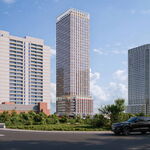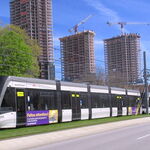Now I must admit it's pretty cool to see Barrie getting All day two way trains on weekends (frequency is bad but not that bad) . Is the only reason the same service doesn't exist during weekdays a lack of rolling stock?
As of today, there is only a single operational siding on the line, which is between Maple and King City stations. A second siding, between YorkU and Rutherford stations, was supposed to be completed in August 2016, but it's behind schedule so it won't begin operation until later this year. That new siding would have allowed the off-peak service to operate every 60 minutes (with a 10-minute layover at Aurora), but for now we're making do with 75-minute off-peak service (with a 46-minute layover at Aurora).
With only a single siding along the line, it's physically impossible to have any counter-peak service, because the existing peak-direction commuter service operates every 30 minutes in the afternoon peak, and every 15 minutes in the morning. A hypothetical counter-peak train would encounter peak-direction trains more frequently than the sidings exist.
With the current track configuration, a weekday service would need to operate over an even more limited time-span than the existing midday service on the Kitchener line. The first and last off-peak Kitchener Line trips do meet peak-direction trips, which wouldn't be possible on the Barrie Line. Once the new Rutherford siding comes on line later this year, it might just be possible to squeeze a single counter-peak train past the start or end of peak-direction service, allowing for midday service with similar hours to the existing Kitchener Line service.
Yup. It has been slow reece, but we are getting there. By 2018. We should have all day service on Stoufville, Barrie, Mt Pleasant at least. Milton should be on the table, unless they liberals want to lose seats out there. I hate the slow pace myself, but we are moving forward which is key.
Actually I don't think the pace is slow at all. GO Transit has seen more service expansion in the last decade than it did for its entire previous history combined. Of course many train lines still operate peak-direction commuter service as they have for decades, but in the meantime we've seen huge expansions of bus service, with half-hourly or better two-way all-day bus service to most train stations, as well as the development of crosstown routes such as the 407 corridor, and the expansion of the service area to include places such as Niagara, Kitchener, Guelph, Brantford and Peterborough. A decade ago Kitchener had no GO service at all, and today it has 4 commuter train round trips per day, hourly express service to Brampton, hourly local service to Square One, frequent express service to Square One or Bramalea/York on certain days and peak-direction express buses from Cambridge to Milton.
The big service expansion is just starting to spread to GO Trains, as the construction projects we started years ago are starting to reach completion. For example, full double-track from Union to Aurora (including the Davenport grade-separation and provision for a future third track), full quad-track from Union to Pearson Junction, finally expanding the pinch point at Bayview Junction (Hamilton), a passing siding at Milliken, full quad-track from Union to Port Credit, and extending the triple track from Guildwood to Pickering.
The Barrie Line is one the furthest along in its service and track expansion. It doesn't have the highest potential new off-peak ridership of the seven train lines, but it is logistically the easiest to implement. But even without the massive train service expansion planned between now and 2018, the rate of service expansion has been quite respectable:
Notes: I'm not sure when service increased from 4 round trips per day to 5. I've shown it as 2011 but that might be off by a year or so. Frequency is measured during the summer (so from 2013-2016 it includes the pilot weekend service).




